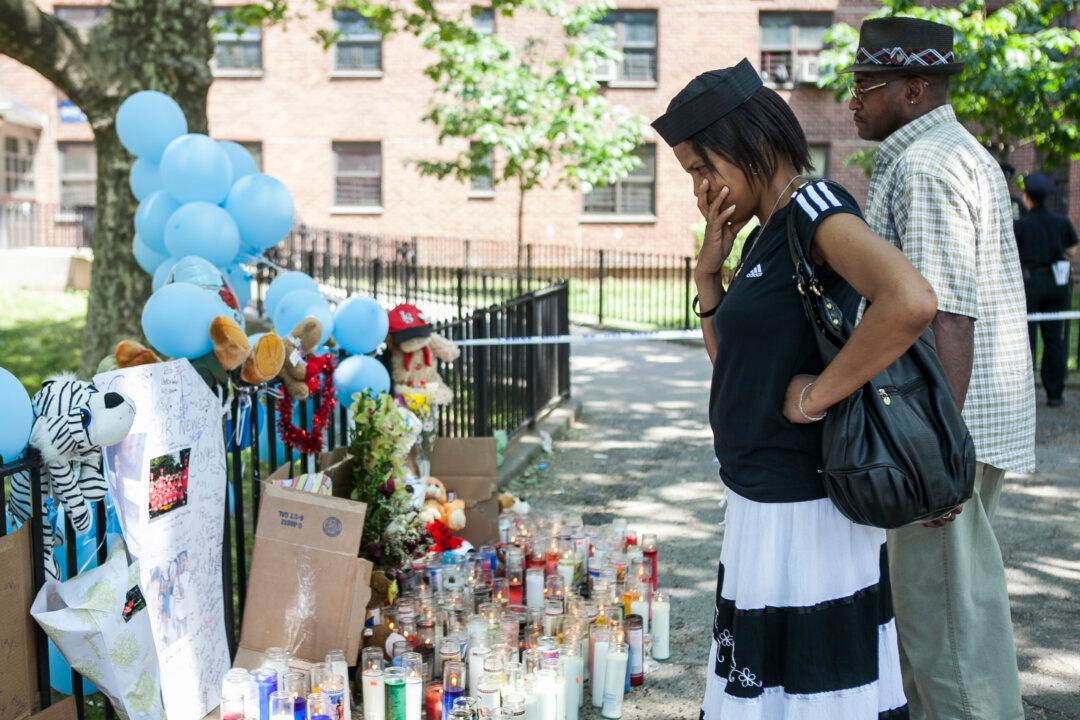Following the stabbing and death of six-year-old Prince Joshua “PJ” Avitto in June at a public housing project in East New York, Brooklyn, local residents expressed outrage at the lack of security cameras.
They argued that cameras could have captured the culprit’s image and deterred criminals from committing wrongdoing in the first place.
Avitto’s death forced Mayor Bill de Blasio to finally address long-standing safety problems in the city’s 334 public housing projects.
In July, he announced a $210 million initiative to reduce crime in the city’s most dangerous housing projects.
The city would target 15 housing developments with the highest crime rates for increased police presence, new security cameras and light towers, and expanded recreational and job programs for its residents.
Twenty percent of the city’s violent crimes occur in public housing projects, according to police department statistics. Public housing residents only make up about 5 percent of the city’s entire population.
On Tuesday, staff from different city agencies provided council members with the first briefing on the initiative’s progress since it started.
Chief of housing at the New York Police Department (NYPD), Carlos Gomez, said that since the department received funding for the initiative on July 1, to date overall crime rates have dropped 7.4 percent in those 15 housing projects, which include the Boulevard Houses where Avitto was killed.
The 15 projects are spread throughout the city, but most are in northeast Brooklyn and the Bronx, including the Brownsville Houses, Bushwick Houses, Butler Houses, and Castle Hill Houses.
Despite the overall crime reduction, six of the 15 targeted housing projects saw an increase in felony assaults, most of which happened in Bushwick Houses, and involved domestic violence cases.
Among all of the city’s public housing projects, crime went down 14.4 percent during the same period. There was a slight increase in shootings, 54 compared to 52 during the same period last year, according to Gomez.
Security Cameras
But residents were most concerned with the slow progress on installing security cameras. At the public hearing held at the Breukelen Houses Community Center in Canarsie, Brooklyn, on Tuesday, president of the Boulevard Houses tenant association Inez Rodriguez said only nine cameras have been installed at the housing project so far, and that the funding did not come from the mayor’s initiative, but from former council member Charles Barron, who represented the district.
“We suffer enough,” Rodriguez said. She called on the mayor to speed up the installation, “so we can have a little peace,” she said, her voice growing frustrated.
Back in June, the mayor, in reaction to Avitto’s death, had approved a $25 million contract for installing cameras at 49 different public housing projects. It was supposed to place an initial number of 17 cameras at Boulevard Houses by October, after years of delay despite secured funding from the city council.
The New York Housing Authority (NYCHA) general manager, Cecil House said on Tuesday that the agency was still working on installing the cameras, which would be completed by the next fiscal year.
House also said that although $50 million has been allocated in the mayor’s plan for maintenance and infrastructure improvement, NYCHA needs $18 billion to fix all the problems within its buildings.
To date, 184 light towers have been installed at housing projects, and 1,500 officers dispatched to the targeted housing projects, according to the director of the mayor’s office of criminal justice, Elizabeth Glazer.
Officers have been patrolling the community centers that have had extended open hours over the summer in the hopes of keeping youth out of trouble.
Glazer also said the mayor’s office is working on compiling a “Comp Stat”-like data tracking system for compiling crime statistics in NYCHA housing, to be rolled out early next year.
Comp Stat is a tool used by the police department to track crimes and arrests in each precinct.
Council members, which included Speaker Melissa Mark-Viverito, chair of the public housing committee Ritchie Torres, chair of public safety committee Vanessa Gibson, and Councilwoman Inez Barron repeatedly asked about including more support services for residents, such as for domestic violence victims and for those seeking mental health services.
They also asked for community organizations to work with police and help intervene in conflicts.
In order to not further tensions between police and the community, “we should not be putting them in jail, or criminalizing them,” Mark-Viverito said.





